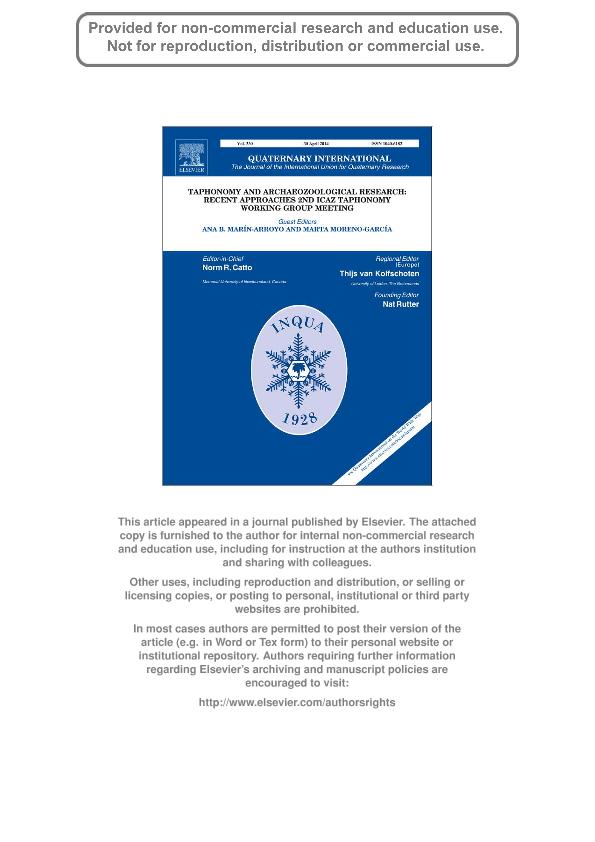Mostrar el registro sencillo del ítem
dc.contributor.author
Tchilingurian, Pablo
dc.contributor.author
Morales, Marcelo Raul

dc.contributor.author
Oxman, Brenda

dc.contributor.author
Lupo, Liliana Concepcion

dc.contributor.author
Olivera, Daniel Enzo

dc.contributor.author
Yacobaccio, Hugo Daniel

dc.date.available
2019-10-03T14:30:14Z
dc.date.issued
2014-04
dc.identifier.citation
Tchilingurian, Pablo; Morales, Marcelo Raul; Oxman, Brenda; Lupo, Liliana Concepcion; Olivera, Daniel Enzo; et al.; Early to Middle Holocene transition in the Pastos Chicos record, dry Puna of Argentina; Pergamon-Elsevier Science Ltd; Quaternary International; 330; 1; 4-2014; 171-182
dc.identifier.issn
1040-6182
dc.identifier.uri
http://hdl.handle.net/11336/85116
dc.description.abstract
This paper presents a multi-proxy record and its paleoenvironmental interpretation from Pastos Chicos (23 400 2900 S; 66 250 3200 W; 3781 m asl), Susques, Jujuy province, Argentina. The analysis includes a study of fluvial sediments and geomorphology, and the contained diatoms and pollen record at centenary resolution. Two main environmental phases characterize the w9000e4200 BP interval. The first phase was a humid period between w9000 and 7300 BP (circa 10,000e8100 cal. BP) which showed organic soils formation in a floodplain broadly vegetated by grasses with a high and stable water table level. The second phase developed between 7300 and 6000 BP (w8100e6800 cal. BP) and showed a moderately drier environment interrupted by punctuated humid events such as those around 7000 and 6300 BP. This environment could be interpreted as a permanently existing meandering river with a floodplain with shallow oxbow lakes, bordered by a diverse shrub steppe. After 6000 BP, the fluvial system turned into a braided river situated in a sandy floodplain with dunes and ephemeral ponds. At the end of the sequence (i.e. post w4200 BP), salt crusts developed and the river lowered its base level by 8 m. These results seem to show that the Pastos Chicos river basin evolved from low energy and more humid conditions established during the Early and the first part of the Middle Holocene, to drier ones in a system with more energy during some events of the second part of the latter period. The start of this aridization process at w6000 BP in the basin, seems to be substantially later than other observations in local records of the Andean area. This could be due to physiographic control of the moisture by the catchment area (w1000 km2) that generates a catchment-averaged regional scale signal of smaller amplitude, which is delayed for individual tributaries. These studies, with other ongoing analysis, will improve the accuracy of the models of resource structure in the area in several spaceetime scales and, consequently, advance knowledge concerning the organizational pattern of human societies in the past.
dc.format
application/pdf
dc.language.iso
eng
dc.publisher
Pergamon-Elsevier Science Ltd

dc.rights
info:eu-repo/semantics/openAccess
dc.rights.uri
https://creativecommons.org/licenses/by-nc-sa/2.5/ar/
dc.subject
PALEOENVIRONMENT
dc.subject
MIDDLE HOLOCENE
dc.subject
PUNA OF ATACAMA-ARGENTINE SECTOR
dc.subject
MULTIPROXY ANALYSIS
dc.subject
HUMAN SOCIETIES
dc.subject.classification
Geociencias multidisciplinaria

dc.subject.classification
Ciencias de la Tierra y relacionadas con el Medio Ambiente

dc.subject.classification
CIENCIAS NATURALES Y EXACTAS

dc.subject.classification
Arqueología

dc.subject.classification
Historia y Arqueología

dc.subject.classification
HUMANIDADES

dc.title
Early to Middle Holocene transition in the Pastos Chicos record, dry Puna of Argentina
dc.type
info:eu-repo/semantics/article
dc.type
info:ar-repo/semantics/artículo
dc.type
info:eu-repo/semantics/publishedVersion
dc.date.updated
2019-10-02T20:53:49Z
dc.journal.volume
330
dc.journal.number
1
dc.journal.pagination
171-182
dc.journal.pais
Países Bajos

dc.journal.ciudad
Amsterdam
dc.description.fil
Fil: Tchilingurian, Pablo. Consejo Nacional de Investigaciones Científicas y Técnicas; Argentina. Universidad de Buenos Aires. Facultad de Ciencias Exactas y Naturales; Argentina
dc.description.fil
Fil: Morales, Marcelo Raul. Consejo Nacional de Investigaciones Científicas y Técnicas; Argentina. Universidad de Buenos Aires. Facultad de Filosofía y Letras. Instituto de Arqueología; Argentina
dc.description.fil
Fil: Oxman, Brenda. Consejo Nacional de Investigaciones Científicas y Técnicas; Argentina. Universidad de Buenos Aires. Facultad de Filosofía y Letras. Instituto de Arqueología; Argentina
dc.description.fil
Fil: Lupo, Liliana Concepcion. Consejo Nacional de Investigaciones Científicas y Técnicas; Argentina. Universidad Nacional de Jujuy; Argentina
dc.description.fil
Fil: Olivera, Daniel Enzo. Consejo Nacional de Investigaciones Científicas y Técnicas; Argentina. Secretaría de Cultura de la Nación. Dirección Nacional de Cultura y Museos. Instituto Nacional de Antropología y Pensamiento Latinoamericano; Argentina
dc.description.fil
Fil: Yacobaccio, Hugo Daniel. Consejo Nacional de Investigaciones Científicas y Técnicas; Argentina. Universidad de Buenos Aires. Facultad de Filosofía y Letras. Instituto de Arqueología; Argentina
dc.journal.title
Quaternary International

dc.relation.alternativeid
info:eu-repo/semantics/altIdentifier/url/http://www.sciencedirect.com/science/article/pii/S1040618212001528
dc.relation.alternativeid
info:eu-repo/semantics/altIdentifier/doi/https://doi.org/10.1016/j.quaint.2012.03.006
Archivos asociados
